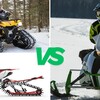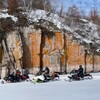
Vintage Rides + Old School Cool: A History of Snowmobiling in Ontario

The snowmobile may be a Quebec invention, but the evolution of the vehicle into a recreational pastime for thousands of outdoor enthusiasts has a unique Northern Ontario twist. Here's the complete history of snowmobiling!

Ontario features the largest interconnected snowmobiling trail and snow tour system in the world, with over 33,000 km of regulated trails and hundreds of snowmobile clubs spanning the province. Yet snowmobiling wasn't always such a community-minded sport. The origins of the snowmobile itself skew more towards function than recreation, while official trail systems were non-existent before the 1960s. In the past century of snowmobile history, everything from trail safety to vehicle speed and reliability has improved exponentially.
A Vehicle Made for Winter Survival
The history of the snowmobile itself traverses the wintery regions of North America, and for that matter, all places where people found themselves snowbound once winter hit. Yet the origins of the first engine-powered snowmobile were in the small town of Valcourt, Quebec, where a young Joseph-Armand Bombardier built the first oversnow vehicle in 1922, fitting a Model T Ford engine to two wooden sleds, a wooden propeller pushing the vehicle slowly through the snow.
Over the next several years, Bombardier worked to build a faster snowmobile, using a sprocket wheel that rotated a double, endless track (it's the same sprocket you'll see on the Bombardier Recreational Products logo today). By 1937, Bombardier was ready to manufacture the B7 snowmobile, made to carry seven passengers and solve the winter transportation problem for families, postal workers, doctors and clergy in Quebec and Ontario. During World War II, Bombardier switched tracks to manufacturing military snow vehicles, officially founding L’Auto-Neige Bombardier Limitée in 1942.

Meanwhile in Wisconsin, Carl Eliason was perfecting his Motor Toboggan, originally built in 1924 as a two-cylinder motorcycle engine on a sled with skis. Once equipped with a single, endless track, he sold them out of his shop before going into production with the FWD Corporation in 1941. The company moved their operation to Kitchener, Ontario in 1947, where Eliason's vehicles were manufactured until 1963.
Not long after the war, Quebec began clearing all secondary roads, changing the course of the snowmobile's evolution towards smaller, faster sleds meant only for one or two people. By 1959, Bombardier launched the Ski-Doo. Intended for trappers, land surveyors, and others who worked far from major roads, the Ski-Doo ended up being a hit among sports enthusiasts. The course of snowmobile history shifted towards recreational use.
Several other machines followed throughout the 50s and 60s, from the Ingham Motor Toboggan to the Polaris Sno Traveler into Bombardier and Arctic Cat’s two-stroke engine snowmobiles and the emergence of Yamaha on the snowmobile scene with the company's two-stroke, twin-cylinder SL350. As with cars, multiple improvements to functionality, suspension and speed followed through the 70s, 80s and 90s, while the 2000s marked the start of four-stroke and four-cylinder snowmobiles.
Today, four major manufacturers build snowmobiles in the U.S. and Canada: Textron/Arctic Cat in Minnesota, BRP in Quebec, Polaris Industries in Minnesota, and Yamaha Motor Corporation in Ontario. Together they sold over 100,000 snowmobiles in 2018, with sales expected to increase even further as the sport gains popularity among multi-generational families. In recent years, the sport has grown even further with the invention of snow bikes.
Snowmobile Clubs Save the Sport and the Trails
The late 60s and early 70s saw a massive boom in recreational snowmobile use, and along with it came noise concerns, environmental damage to forests, creeks and fields, and serious safety issues. As Canadian provinces instituted legislation on snowmobiles, extensive trail systems and community-run snowmobile clubs began to emerge as a grassroots way to keep snowmobiling alive.

As independent snowmobile clubs gained membership throughout Ontario, several banded together in 1967 to form an umbrella organization that's still going strong today as a provincial federation: the Ontario Federation of Snowmobile Clubs. A non-profit association lead by volunteers, the OFSC is focused on creating “exceptional snowmobile trails and rider experiences.”
By 1980, the OFSC had implemented a Driver Training Program to increase trail safety. The OFSC, other clubs and organizations like the Ontario Trail Builders Alliance banded together to maintain the trails through a permit system that would give them the funds to do it well. Since then, they've expanded to over 200 clubs, and even initiated an Interactive Trail Guide mapping tool to make sure no one gets lost in the woods.
Within the 17 districts in the OFSC today, club trails form interconnected networks from Southwestern Ontario to Kenora, with each district home to several snowmobile clubs that sell permits and whose volunteer members maintain the trails. Even clubs who aren't members work with OFSC clubs to make sure all trails stay safe, well-signed, and a thrill to ride, no matter what the winter weather.
Recommended Articles

The Complete List of Snowmobile Events in Ontario 2025-2026

The Best Snowmobile-Friendly Lodges
Snowmobiling Winter Weather Forecast 2025-2026

I Rode the Explorers Snow Tour in Ontario and Here’s What It Was Like

Why Ontario is One of the Best Snowmobile Destinations in the World

11 TikToks That Prove Ontario is the Best Place To Go Snowmobiling

5 Weekend Snowmobile Getaways Near the GTA

31 Ways To Get In The Know About Snowmobile Trail Riding in Ontario

A Beginner's Guide to Snowmobile Lingo































